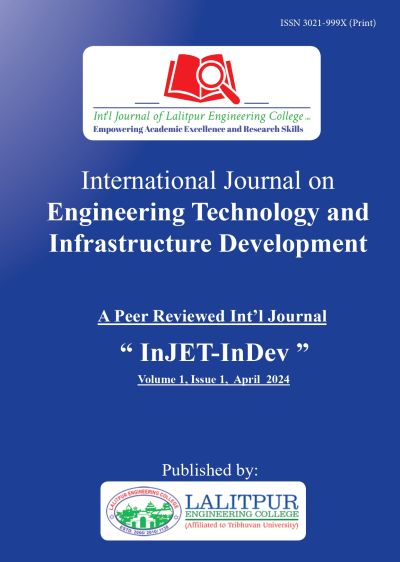Comparative Analysis of Polypropylene Fiber for Rigid Airfield Pavement: Case study of Apron of Gautam Buddha International Airport
DOI:
https://doi.org/10.3126/injet-indev.v1i1.67932Keywords:
Polypropylene Fiber, Airport ApronAbstract
Airfield pavements come in three main types: rigid, flexible, and composite. Rigid pavements, made of Portland Cement Concrete (PCC) slabs on a prepared sub base or base, face challenges due to poor strength in tension and flexure. To address this, Polypropylene Fiber Reinforced Concrete (PFRC) has been introduced, enhancing toughness, flexural strength, tensile strength, and impact resistance. This study aims to compare rigid airfield pavement with PCC surface courses, with and without polypropylene fiber, focusing on strength parameters, thickness, and cost. The research asserts that PFRC serves as an effective modification technique for PCC, promoting effective rigid airfield pavement design. Strength parameters, including compressive strength, split tensile strength, and flexural strength, were assessed. Split tensile strength at 28 days increased by 18%, and flexural strength increased by 14.50%, demonstrating the positive impact of polypropylene fiber. In terms of pavement thickness, the PCC surface course of rigid airfield pavement with polypropylene fiber was 393 mm, while without it was 453 mm, showcasing potential thickness reduction. Total pavement thickness for design air traffic was 943 mm with polypropylene fiber and 1003 mm without. This reduction in thickness indicates a potential for material efficiency without compromising performance.
Downloads
Downloads
Published
How to Cite
Issue
Section
License
Copyright (c) 2024 International Journal on Engineering Technology and Infrastructure Developmen

This work is licensed under a Creative Commons Attribution 4.0 International License.
This license enables reusers to distribute, remix, adapt, and build upon the material in any medium or format, so long as attribution is given to the creator. The license allows for commercial use.




